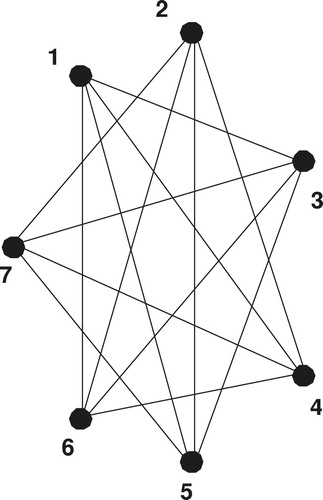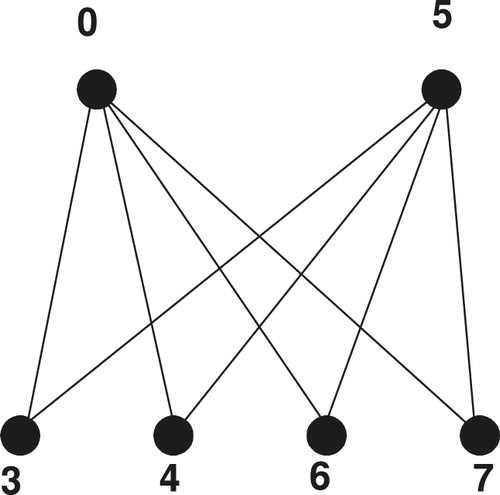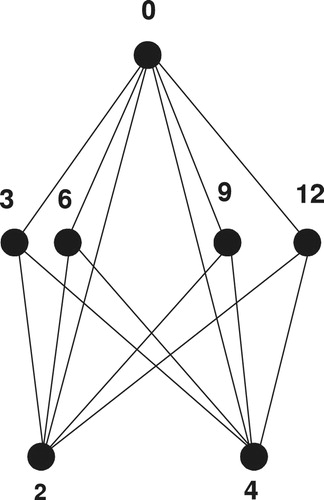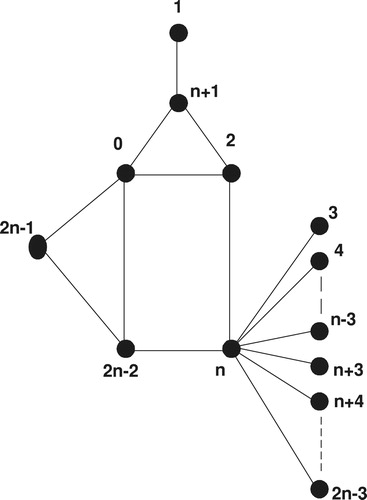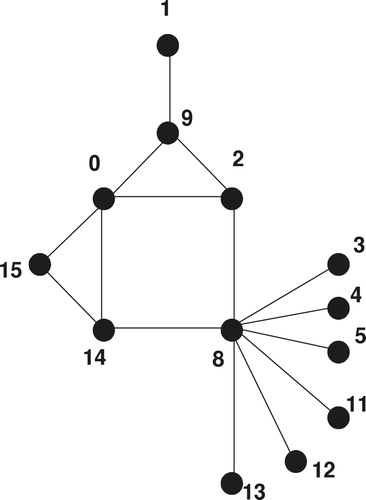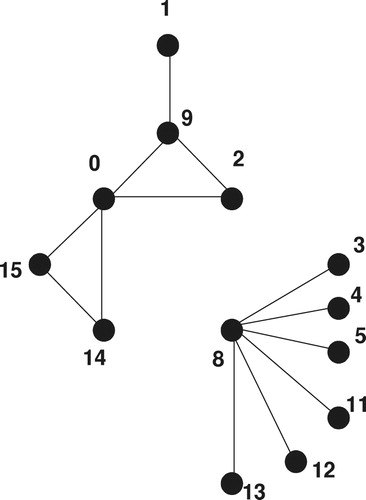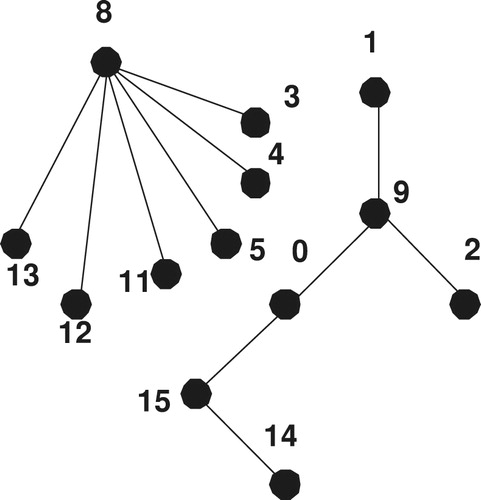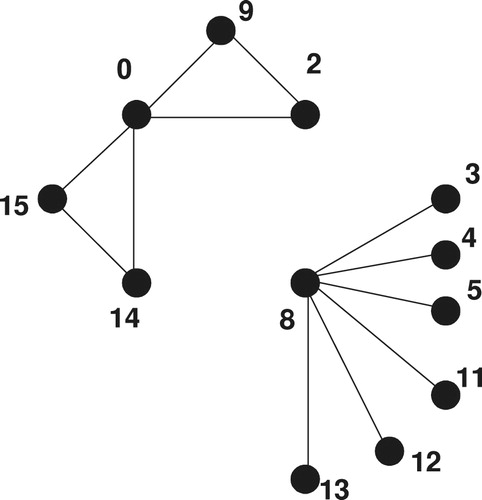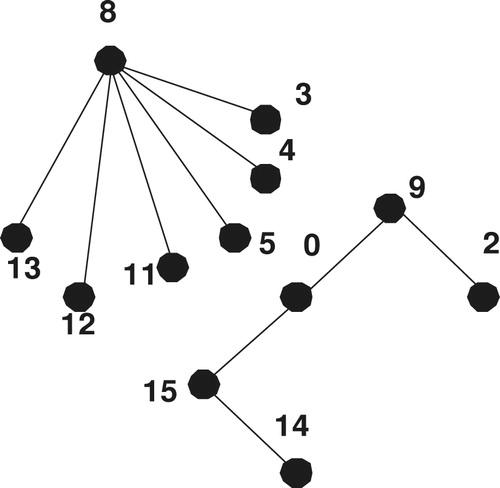 ?Mathematical formulae have been encoded as MathML and are displayed in this HTML version using MathJax in order to improve their display. Uncheck the box to turn MathJax off. This feature requires Javascript. Click on a formula to zoom.
?Mathematical formulae have been encoded as MathML and are displayed in this HTML version using MathJax in order to improve their display. Uncheck the box to turn MathJax off. This feature requires Javascript. Click on a formula to zoom.Abstract
In this article, a technique to construct cyclic orthogonal double covers (CODCs) of regular circulant graphs by certain infinite graph classes such as complete bipartite and tripartite graphs and disjoint union of butterfly and is introduced.
1 Introduction
Let be a graph with vertex set
. A collection
of isomorphic spanning subgraphs (called pages) of
is an orthogonal double cover (ODC) of
by
if the following two conditions hold
(1) Every edge in belongs to exactly two of the pages (double cover property) and
(2) and
share an edge if and only if
and
are adjacent in
(orthogonality).
This concept is a natural generalization of earlier definitions of an ODC for complete and complete bipartite graphs, that have been studied extensively (see the survey [Citation1]). The necessary condition for an ODC of by
is that
is regular.
An effective technique to construct ODCs in the above cases was based on the idea of translating a given subgraph of by a group acting on
.
The purpose of this article is to investigate the existence of cyclic orthogonal double covers of circulant graphs. The existence problem of ODCs by given graphs has attracted much attention during the last 10 years. The problem is known to be hard in general as it includes some long-standing open problems like the existence problems of biplanes as special cases. Also, the ODC problem originally stems from problems in database optimization and statistical design, and design theory. In [Citation2,Citation3], Demetrovics et al. investigated Armstrong database of minimum size for key and functional dependence. Armstrong database of size
is equivalent to ODCs of
whose pages consist of distinct cliques. The problem, however, subsequently earned a life of its own, resulting in a relatively rich literature, generalizing the problem to an expanding class of graphs, whereas the initial interest was connected to complete graphs. Research on ODCs has motivated the development of various direct and recursive methods for constructing ODCs. This article contains seven technical results (four theorems and three corollaries), regarding the existence of cyclic ODCs for certain classes of regular circulant graphs (of which complete graphs are a special case).
An automorphism of an ODC of
is a permutation
such that
where
is a subgraph of
with
and
An ODC
of
is cyclic (CODC) if the cyclic group of order
is a subgroup of the automorphism group of
.
Let be an Abelian group with identity
be a subset of
satisfying
and
-that is,
if and only if
. The Cayley graph Cay(
) on
with connection set
is defined as follows (i) the vertices are the elements of
and (ii) there is an edge joining
and
if and only if
for some
. The Cayley graphs on cyclic groups have played a special role in the study of Cayley graphs. They are widely known as circulant graphs, because their adjacency matrices are circulant matrices. We use the notation Circ(
) to denote the circulant graph of order
with connection set
The length of an edge
in Circ
is defined by
An example, the circulant graph Circ(
) is given in .
In this article we make use of the usual notation: for the complete bipartite graph with partition sets of sizes
and
,
for the complete graph on
vertices,
for the disjoint union of
and
,
for the complete tripartite graph with partition sets of sizes
and
,
for the path on
vertices
and
represents the graph obtained by removing the edges of a subgraph
from the graph
, where the graphs
and
are spanning subgraphs of
. Let
be positive integers,
and
for
the caterpillar
is the tree obtained from the path
by joining vertex
to
new vertices,
Orthogonal labelling notion is introduced by the authors of [Citation1]. Given a graph with
edges, a
mapping
is an orthogonal labelling of
if
contains exactly two edges of length
and exactly one edge of length
if
is even, and
is the rotation-distance between two edges, see [Citation1].
Gronau et al. [Citation1] relates CODCs of and the orthogonal labelling by the following theorem.
Theorem 1
[Citation1]
A CODC of
by a graph
exists if and only if there exists an orthogonal labelling of
.
The following theorem of Sampathkumar and Srinivasan is a generalization of Theorem 1.
Theorem 2
[Citation4]
A CODC of
by a graph
exists if and only if there exists an orthogonal
-labelling of
.
For results on orthogonal double cover of circulant graphs, see [Citation4Citation5–Citation7]. In [Citation1Citation8–Citation10], other results of ODCs by different graph classes can be found. In [Citation11], the other terminology not defined here can be found. We use Theorem 2 to prove the existence of CODC of circulant graphs by a graph .
2 CODCs of circulant graphs by complete bipartite and tripartite graphs
Theorem 3
For all positive integers
, there exists a CODC of
regular Circ
by
Proof
Let us define by
where
, and
where
. Then the edges of lengths
, where
, are
, and
and the edges of lengths
, where
are
, and
Hence for
contains exactly two edges of length
, and since every two edges of the same length are adjacent
Hence
has an orthogonal labelling.
A CODC generating graph of regular Circ
by
is shown in .
Theorem 4
For any positive integer
, there exists a CODC of
regular Circ
by
Proof
Let us define by
, and
, where
.
.
Case 1.
.
The edges of length are
and
the edges of length
are
and
the edges of length
are
and
the edges of length
where
are
and
the edges of length
where
are
and
the edges of length
where
are
and
Hence for
,
contains exactly two edges of length
, and
Hence
has an orthogonal labelling.
Case 2.
.
The edge of length is
the edges of length
are
and
the edges of length
are
and
the edges of length
are
and
the edges of length
where
are
and
the edges of length
where
are
and
the edges of length
where
are
and
Hence for
,
contains exactly two edges of length
, and
Hence
has an orthogonal labelling.
A CODC generating graph of regular Circ
by
, is shown in .
3 CODCs of regular circulant graphs by certain graph 

Let (as shown in ) be a graph with the edge set:
, where
is defined by
, where
, where
. We denote by
the vertex set of the graph
Theorem 5
For all positive integers
, there exists a CODC of
regular Circ
by
Proof
The edge of length is
the edges of length
are
and
the edges of length
are
and
the edges of length
where
are
and
the edges of length
are
and
the edges of length
are
and
. Hence for every
,
contains exactly two edges of length
and exactly one edge of length
, and
. Hence
has an orthogonal labelling.
A CODC generating graph of regular Circ
by
, is shown in .
For the following Corollary,
Corollary 6
For all positive integers
, there exists a CODC of
regular Circ
by
Proof
The edge of length is
the edges of length
are
and
the edges of length
are
and
the edges of length
where
are
and
the edges of length
are
and
. Hence for every
,
contains exactly two edges of length
, and exactly one edge of length
, and
. Hence
has an orthogonal labelling.
A CODC generating graph of regular Circ
by
, is shown in .
For the following Corollary,
Also, we denote by the caterpillar
with
and
Corollary 7
For all positive integers
, there exists a CODC of
regular Circ
by
Proof
The edge of length is
the edges of length
are
and
the edges of length
where
are
and
the edges of length
are
and
. Hence for every
,
contains exactly two edges of length
, and exactly one edge of length
, and
. Hence
has an orthogonal labelling.
A CODC generating graph of regular Circ
by
, is shown in .
4 CODCs of regular circulant graphs by disjoint union of butterfly and 

Let (as shown in ) be a graph with the edge set:
where
is defined by
, where
, where
We denote by
the vertex set of the graph
.
Theorem 8
For all positive integers
, there exists a CODC of
regular Circ
by
Butterfly
Proof
The edges of length are
and
the edges of length
are
and
the edges of length
where
are
and
the edges of length
are
and
. Hence for every
,
contains exactly two edges of length
, and
. Thus
has an orthogonal labelling.
A CODC generating graph of regular Circ
by
Butterfly
, is shown in .
For the following Corollary,
, where
is defined by
, where
, where
Corollary 9
For all positive integers
, there exists a CODC of
regular Circ
by
Proof
The edges of length are
and
the edges of length
where
are
and
the edges of length
are
and
. Hence for every
,
contains exactly two edges of length
, and
. Thus
has an orthogonal labelling.
A CODC generating graph of regular Circ
by
, is shown in .
Notes
Peer review under responsibility of Kalasalingam University.
References
- Gronau H.-D.O.F. Mullin R.C. Rosa A. On orthogonal double covers of complete graphs by trees Graphs Combin 13 1997 251 262
- Demetrovics J. Füredi Z. Katona G.O. H. Minimum matrix representations of closure operations Discrete Appl. Math. 11 1985 115 128
- Demetrovics J. Katona G.O. H. Extremal combinatorial problems in relational data base Fundamentals of Combinatorials of Computation Theory 11 (1981) Springer. Berlin. 110–119.
- Sampathkumar R. Srinivasan S. Cyclic orthogonal double covers of 4-regular circulant graphs Discrete Mathematics 311 2011 2417 2422
- Higazy M. On Cyclic orthogonal double covers of circulant graphs using infinite graph classes Br. J. Math. Comput. Sci. 3 3 2013 425 436
- El Shanawany R. Shabana H. On Orthogonal double covers of circulant graphs Br. J. Math. Comput. Sci. 4 3 2014 394 401
- El-Shanawany Ramadan. El-Mesady Ahmed. On Cartesian products of orthogonal double covers of circulants J. Math. Res. 6 4 2014 118 123
- El Shanawany R. Higazy M. Scapellato R. A note on orthogonal double covers of complete bipartite graphs by a special class of six caterpillars AKCE Int. J. Graphs Comb. 7 2010 1 4
- El Shanawany R. Higazy M. Shabana H. El Mesady A. Cartesian product of two symmetric starter vectors of orthogonal double covers AKCE Int. J. Graphs Comb. 12 2015 59 63
- El Shanawany R. Higazy M. El Mesady A. On Cartesian products of orthogonal double covers Int. J. Math. Math. Sci. 2013 2013 4 10.1155/2013/265136
- Balakrishnan R. Ranganathan K. A Textbook of Graph Theory second ed. 2012 Universitext, Springer New York, NY, USA

